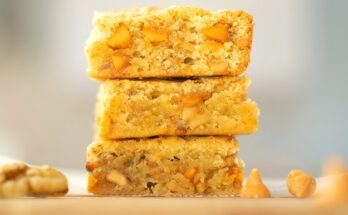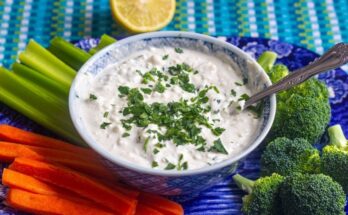Matcha Cookie Recipe: Cookies are the ultimate comfort snack, but when you add the unique flavor of matcha, you take them to a whole new level. Imagine biting into a soft, chewy cookie with the earthy yet slightly sweet taste of matcha green tea—it’s a treat that feels indulgent but still refined. Matcha cookies are not only delicious but also a little more special than your standard chocolate chip batch. They stand out at gatherings, make wonderful gifts, and are surprisingly simple to bake at home.
In this detailed guide, we’ll walk through everything you need to know—from ingredients and tools to step-by-step baking instructions. By the end, you’ll have all the knowledge and confidence you need to bake bakery-worthy matcha cookies in your own kitchen.
What Makes Matcha Cookies Special
Matcha cookies are more than just another sweet snack. What makes them stand out is their unique balance of flavors: slightly bitter, earthy matcha powder paired with the sweetness of sugar and the richness of butter. Unlike traditional cookies, matcha cookies have a distinct green hue that instantly catches the eye and makes them look gourmet, even if you’re just baking them for a cozy afternoon at home.
Another reason these cookies are special is versatility. You can keep them simple and classic, or enhance them with add-ons like white chocolate chips, macadamia nuts, or even a drizzle of dark chocolate. The earthy flavor of matcha pairs beautifully with sweet and creamy ingredients, making it an excellent canvas for creativity.
Lastly, there’s the health aspect. While cookies are still a treat, adding matcha brings in antioxidants, amino acids, and other nutrients that give you a subtle energy boost without the crash of coffee. That makes matcha cookies a little more guilt-free compared to other desserts.
The Origins of Matcha in Baking
Matcha has a long history in Japanese tea culture, where it’s been used in traditional tea ceremonies for centuries. In modern times, its use has expanded beyond just drinks. Today, matcha is a popular ingredient in lattes, smoothies, cakes, and of course, cookies.
The rise of matcha in Western baking can be traced to its growing popularity as a “superfood.” Food enthusiasts, bakers, and chefs embraced matcha for its vibrant color and distinct flavor, and soon recipes like matcha cheesecakes, matcha brownies, and matcha cookies became staples in trendy cafes and bakeries around the world.
By combining traditional baking methods with this traditional Japanese ingredient, we get a dessert that’s both familiar and new—comforting like cookies, but exotic thanks to the matcha.
Ingredients You’ll Need
When it comes to baking, the ingredients you choose make all the difference. For matcha cookies, freshness and quality matter even more, since the flavor and color of matcha can vary greatly depending on its grade and origin.
Dry Ingredients for the Recipe
- All-Purpose Flour (2 cups / 240g): Provides the structure for your cookies. You can substitute with gluten-free flour if needed.
- Matcha Powder (2 tablespoons): The star of the recipe. Choose culinary-grade matcha for baking—it’s more affordable than ceremonial grade and works beautifully in recipes.
- Baking Soda (1 teaspoon): Helps the cookies rise slightly and adds a light texture.
- Salt (½ teaspoon): Balances the sweetness and enhances the flavors.
Wet Ingredients for the Recipe
- Unsalted Butter (½ cup / 113g): Softened to room temperature. Butter adds richness and gives the cookies their soft texture.
- Granulated Sugar (½ cup / 100g): For sweetness and structure.
- Brown Sugar (½ cup / 110g): Adds moisture and a chewy texture with a hint of caramel flavor.
- Egg (1 large): Acts as a binder, holding the dough together.
- Vanilla Extract (1 teaspoon): Enhances the flavor and adds warmth to balance the matcha.
Optional Add-Ons to Customize Your Cookies
- White Chocolate Chips: Add creaminess and sweetness that pairs perfectly with matcha.
- Macadamia Nuts or Almonds: For crunch and nutty flavor.
- Dark Chocolate Chunks: Create a more complex, slightly bitter balance.
- Dried Cranberries: Add a tart, fruity contrast to the earthy matcha.
The best part about this recipe is its flexibility. You can stick to the basics or get creative with different combinations depending on your taste.
Kitchen Tools and Equipment
Just like with any other baking project, the right tools can make the process smoother and more enjoyable. Luckily, you don’t need anything fancy—most of these are likely already in your kitchen.
Essential Baking Tools
- Mixing bowls (large and medium)
- Measuring cups and spoons
- Whisk and spatula
- Hand mixer or stand mixer
- Baking sheet
- Parchment paper or silicone baking mat
- Wire cooling rack
Recommended Substitutes if You Don’t Have Them
- No Stand Mixer? Use a whisk and some elbow grease—it’ll take a little longer but still works.
- No Parchment Paper? Grease the baking sheet with butter or cooking spray to prevent sticking.
- No Cooling Rack? Place cookies on a clean plate or tray, though they might take a little longer to cool evenly.
Step-by-Step Guide to Making Matcha Cookies
Now that you have your ingredients and tools ready, it’s time to bring everything together. Baking is part science, part art, and following each step carefully will ensure your cookies come out just right.
Step 1 – Preparing the Ingredients
Gather your baking essentials: all-purpose flour, unsalted butter (softened), sugar, an egg, baking powder, salt, and high-quality matcha green tea powder. For an extra treat, you can also add white chocolate chips or chopped nuts. Make sure the butter is at room temperature for easy mixing.
Step 2 – Mixing the Dough
In a bowl, cream the butter and sugar together until light and fluffy. Beat in the egg until fully combined. In a separate bowl, sift together the flour, baking powder, salt, and matcha powder. Gradually add the dry mixture to the wet mixture, stirring until a smooth dough forms. If adding chocolate chips or nuts, fold them in at this stage.
Step 3 – Shaping the Cookies
Scoop out portions of dough with a spoon or cookie scoop and roll them into small balls. Place them on a parchment-lined baking tray, leaving space between each one to allow for spreading. Gently flatten the tops with your hand or the back of a spoon for even baking.
Step 4 – Baking to Perfection
Preheat your oven to 350°F (175°C). Bake the cookies for 10–12 minutes, or until the edges are slightly golden but the centers are still soft. Avoid overbaking, as this can make the cookies dry instead of chewy.
Step 5 – Cooling and Serving
Remove the cookies from the oven and let them cool on the tray for a few minutes before transferring to a wire rack. Once cooled, serve them with a cup of tea, coffee, or a glass of milk. The earthy matcha flavor pairs wonderfully with sweet white chocolate or a simple buttery base.
Tips for Perfect Matcha Cookies Every Time
Baking is part science, part creativity. To ensure your cookies turn out flawless every time, here are some tried-and-true tips:
Choosing the Right Matcha Powder
Not all matcha is created equal. For baking, you don’t need the highest ceremonial grade, but you should still choose a good-quality culinary-grade powder. Look for a bright, vibrant green color—dull or yellowish matcha often means it’s old or lower quality, which can result in a bitter aftertaste.
When possible, buy matcha that comes in a sealed, opaque container to protect it from light and air. Store it in the refrigerator after opening to keep it fresh longer.
How to Keep Cookies Soft and Chewy
- Don’t overmix the dough. Overworking develops too much gluten, which makes cookies tough.
- Chill the dough before baking to control spreading.
- Slightly underbake the cookies for a soft, chewy center.
- Store them in an airtight container with a slice of bread—the bread releases moisture that keeps the cookies soft.
Common Mistakes to Avoid
- Using too much flour: This makes the cookies dense and dry. Always measure flour correctly using the spoon-and-level method.
- Skipping the sifting step: Matcha tends to clump easily, so sifting ensures even distribution.
- Overbaking: This ruins both the texture and the color of your cookies.
- Using melted butter: Softened butter is key for proper creaming; melted butter will make the dough greasy.
By paying attention to these details, you’ll consistently bake cookies that look and taste like they came straight from a professional bakery.
Variations of Matcha Cookies
One of the best things about matcha cookies is their versatility. Once you’ve mastered the basic recipe, you can experiment with different add-ins and adjustments to suit your taste preferences or dietary needs. Here are some delicious variations worth trying:
Matcha White Chocolate Chip Cookies
This is probably the most popular twist on matcha cookies, and for good reason. The sweetness of creamy white chocolate pairs beautifully with the earthy, slightly bitter notes of matcha. The white chocolate also creates a striking color contrast against the vibrant green dough.
To make this version, simply fold in about 1 cup of white chocolate chips into your dough right before chilling. You can also press a few extra chips onto the tops of the dough balls before baking for that picture-perfect finish. These cookies are a crowd-pleaser and often the easiest way to introduce someone to matcha-flavored desserts.
Vegan Matcha Cookies
Don’t worry if you’re plant-based—matcha cookies can easily be made vegan-friendly without sacrificing taste or texture. Replace the butter with vegan butter or refined coconut oil, and substitute the egg with a flax egg (1 tablespoon ground flaxseed mixed with 3 tablespoons of water). Use dairy-free chocolate chips if you’d like to add them.
The result? Soft, chewy cookies with the same rich flavor as the classic version, but entirely plant-based.
Gluten-Free Matcha Cookies
For those with gluten sensitivities, you can make these cookies using a gluten-free all-purpose flour blend. Look for a blend that contains xanthan gum or another binder to mimic the texture of wheat flour. If your blend doesn’t have it, you may need to add a pinch of xanthan gum yourself.
When made correctly, gluten-free matcha cookies turn out just as delicious as the original. They may have a slightly different texture—sometimes a little softer or more crumbly—but the flavor remains outstanding.
Other creative variations include adding macadamia nuts for a tropical flair, cranberries for a tart contrast, or even a drizzle of dark chocolate for a more indulgent cookie.
Storing and Preserving Your Cookies
Freshly baked cookies are irresistible, but sometimes you want to save a batch for later. Storing matcha cookies properly ensures they stay soft, flavorful, and just as delightful as when they first came out of the oven.
How Long Do They Last?
At room temperature, matcha cookies stay fresh for about 4 to 5 days if kept in an airtight container. Be sure to store them away from direct sunlight to maintain their vibrant green color. If left uncovered, they’ll dry out quickly and lose that chewy texture.
If you’d like them to last longer, store them in the refrigerator. Chilled cookies can keep for up to 10 days, although they may firm up slightly. Just pop them in the microwave for 5–10 seconds before eating to bring back the softness.
Freezing Instructions
Freezing is an excellent option if you want to enjoy cookies over a longer period. You can freeze them in two ways:
- Freeze the Dough: Scoop the cookie dough into balls, place them on a baking sheet, and freeze until solid. Once frozen, transfer the dough balls to a zip-lock bag. When you’re ready to bake, simply place them on a baking sheet and bake directly from frozen—just add 1–2 minutes to the baking time.
- Freeze Baked Cookies: Allow cookies to cool completely, then layer them between sheets of parchment paper in a freezer-safe container. They’ll keep for up to 3 months. To enjoy, thaw at room temperature or warm them in the oven for a few minutes.
Freezing not only preserves flavor and freshness but also makes it easy to bake a small batch whenever a craving strikes.
Serving Ideas and Pairings
Matcha cookies are delicious on their own, but pairing them with the right drink or serving them in a creative way can elevate the entire experience.
Drinks That Go Well with Matcha Cookies
- Matcha Latte: Double up on matcha flavor by pairing your cookies with a creamy matcha latte.
- Green Tea: Keep it traditional with a hot cup of Japanese green tea. The light, grassy notes complement the cookies perfectly.
- Coffee or Espresso: The bitterness of coffee balances the sweetness of the cookies beautifully.
- Milk (Dairy or Plant-Based): A classic pairing that’s comforting and kid-friendly.
Creative Ways to Serve Them
- Ice Cream Sandwiches: Place a scoop of vanilla or matcha ice cream between two cookies for a refreshing dessert.
- Cookie Crumble Topping: Crumble the cookies over yogurt, parfaits, or cheesecake for extra flavor and texture.
- Gift Boxes or Party Favors: Wrap them individually in parchment and ribbon for a homemade gift that looks as good as it tastes.
Serving matcha cookies with a thoughtful pairing or presentation makes them suitable for everything from casual afternoon snacks to elegant dessert tables.
Health Benefits of Matcha in Cookies
Even though cookies are considered indulgent, the addition of matcha provides some unique health perks that make this treat a little more balanced.
Nutritional Value of Matcha
Matcha is packed with nutrients, including vitamins A, C, and E, as well as minerals like magnesium and potassium. Unlike regular green tea, where the leaves are steeped and discarded, matcha is ground into a fine powder and consumed entirely, which means you’re getting all of its goodness in every bite.
Antioxidant Benefits
One of the standout benefits of matcha is its high concentration of antioxidants, particularly catechins. These compounds help protect your body from free radicals, which can cause cell damage. Matcha has even been linked to improved metabolism, better focus, and a more stable energy boost compared to coffee.
Of course, cookies are still a dessert and should be enjoyed in moderation, but knowing that your sweet treat also brings along some nutritional benefits makes it even more enjoyable.
FAQs about Matcha Cookie Recipe
1. What kind of matcha powder should I use for cookies?
Culinary-grade matcha is best for baking. It’s affordable, has a slightly stronger flavor, and works perfectly in baked goods without compromising quality.
2. Can I make these cookies without butter?
Yes! You can substitute butter with coconut oil or vegan butter. Just note that the texture may differ slightly, but the taste remains delightful.
3. How do I make my cookies chewier?
Use more brown sugar than granulated sugar, chill the dough before baking, and slightly underbake the cookies for a soft, chewy center.
4. Can I add nuts or dried fruits to this recipe?
Absolutely! Nuts like macadamia, almonds, or walnuts, as well as dried cranberries or cherries, add wonderful texture and flavor.
5. Are matcha cookies kid-friendly?
Yes, they are! While matcha does contain a little caffeine, it’s much less than coffee, and in cookie form, it’s usually safe for kids in moderation.
Conclusion
Matcha cookies are the perfect blend of tradition and modern baking—a treat that’s as beautiful as it is delicious. With their vibrant green color, earthy flavor, and soft, chewy texture, they stand out from ordinary cookies and bring a little elegance to everyday snacking.
Whether you stick to the classic recipe or try out fun variations like vegan, gluten-free, or white chocolate chip, there’s a matcha cookie for everyone. With the step-by-step guide above, you now have all the tools you need to bake them like a pro.
So grab your whisk, preheat the oven, and let the aroma of freshly baked matcha cookies fill your kitchen—you won’t regret it.



